[ 2006 | 2007 | 2008 | 2009 | 2010 | 2011 | 2012 | 2013 | 2014 | 2015 | 2016 | 2017 | 2018 | 2019 | 2020 | 2021 | 2022 | 2023 | 2024 | 2025 | 2026 ]
2023 Shelfwide Cruise: July 22 - July 28
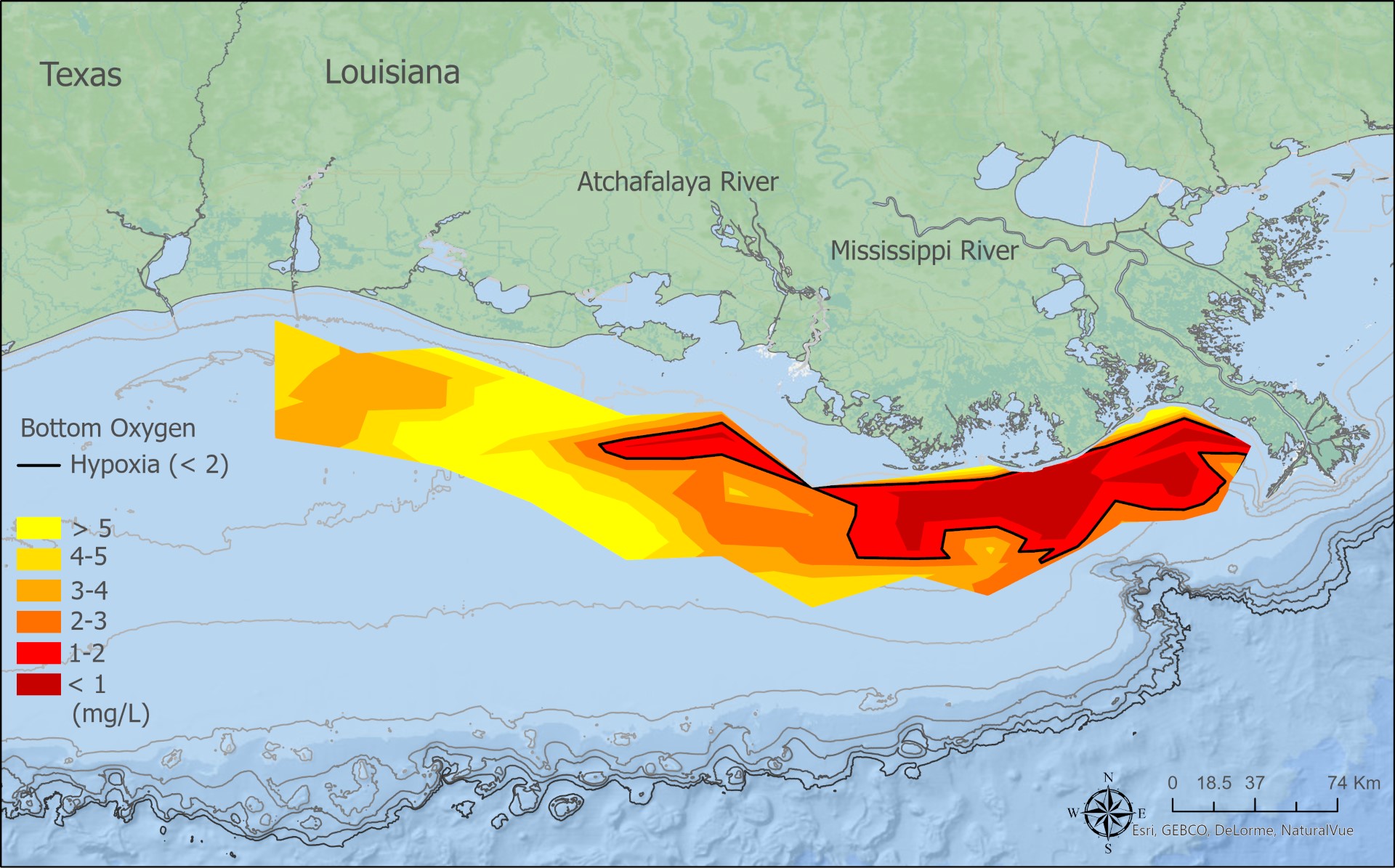
Hypoxia ForecastPress Release
Daily LogMississippi River Discharge
Photo GalleryMarine Forecast
Additional MapsGraphs
Daily Log
- Hi!
- Whale hello there!
My name is Tori and I will be your cruise fairy for the 2023 Shelfwide Hypoxia Cruise. I have previously joined this science crew in 2020, and have been so kindly invited to return for another fantastic voyage on the R/V Pelican. This year, the cruise will go from July 23rd to July 31st (unless we finish early) as the science crew maps out this year’s Dead Zone. The onboard science crew includes myself, Dr. Glaspie, Gina, Emily, Jill, Ariel, Abby, Brock, and Kristen. Members of the science crew on land consist of Dr. Nancy Rabalais, Wendy, and Leslie. As your cruise fairy, I aim to bring you content that is educational, informational, and fun! I’m so glad you can join us for the 2023 Shelfwide Hypoxia Cruise. I’ll talk to you soon!
- Motivation Monday
-
At 4:45 a.m. this morning, already an hour and a half into a day’s work, it seemed like a good time to ask what motivates the science crew to take on 12 hour shifts of sometimes non-stop fieldwork on board the Pelican for 8 days. the science crew was asked, “What Motivated you to…go into the science field/do this kind of work”?Emily:“I’ve always been curious.”Emily’s pastime, while waiting for the school bus to pick her up, was to write down fun facts from a science books. That fueled her love of science and curiosity. When it comes to this field specifically, her “love for charismatic wildlife” and her fascination with fish drive her to this work. However, she paints a broadstroke with her interests and likes to work in as many different labs as possible. “The more I can know, the better.”One common motivation of the many of the day shift crew was said well by Emily: “I like playing and getting dirty!”Dr. Glaspie:I like seeing new and surprising things. It engages my brain. While the forest is peaceful for Dr. Glaspie, she is drawn to the Ocean because its constant changing does surprise her so much.“Every time you go out the door, something cool is in the water or there’s a really cool landscape.” There’s always something new and exciting to see out here for Dr. Glaspie!Along with the surprises of nature, Dr. Glaspie enjoys the balance of mental and physical challenges involved in her work!Abby:From a young age, Abby has always enjoyed “being a kid outside. The mess of it all.” Then, as she moved to Louisiana (from Ohio) and saw the affects of big industries like oil and gas on the environment and on people, she has become even more motivated to study how the planet is affected by people and what can be done about it.Another big motivator for Abby is being in a lab with a lot of women, and in general being in a lab with good people. Doing great work with so many great scientists motivates Abby to do science.“I think it’s just the coolest job you could possibly have!”Kristen:[Jokingly] “I like to be tired.”
- It’s TWOS-day!!!
-
After 2 days out in the Gulf with the crew, we’ve started noticing how many things come in twos!2 different instruments cast from the a-frame: CTD rosette and YSI. These instruments contain sensors that provide data such as Temperature, pH, Salinity, Conductivity, Dissolved Oxygen, Chlorophyll, Depth, and more. These measurements are important for determining the amount of (or lack of) oxygen in the water, nutrients in the water, visibility of the water, and other factors.
 2 protective pieces of equipment must be worn when working out on the back deck: personal flotation device and a hard hat. When casting the CTD and YSI, using heavy machinery requires the extra protection.
2 protective pieces of equipment must be worn when working out on the back deck: personal flotation device and a hard hat. When casting the CTD and YSI, using heavy machinery requires the extra protection.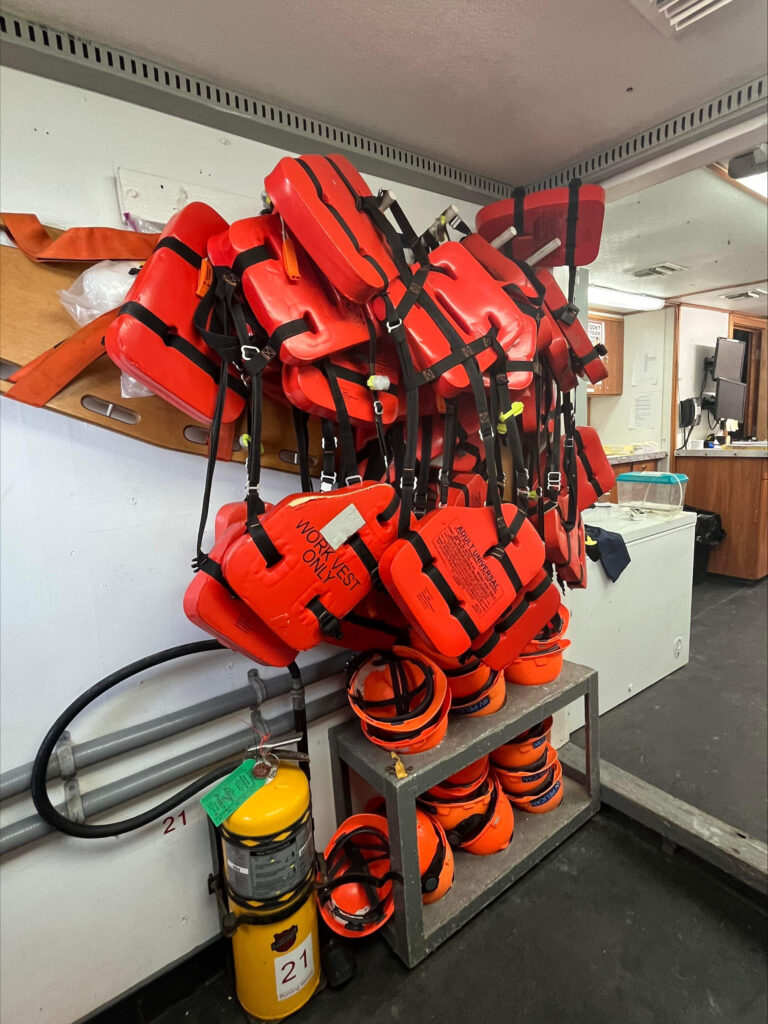 2 gloves worn for various lab procedures to avoid contamination of samples.2 samples of nutrients are taken at each station (surface and bottom). We take these because conditions on the surface of the water are not always the same as the bottom.2 vials of each nutrient sample (a spare)
2 gloves worn for various lab procedures to avoid contamination of samples.2 samples of nutrients are taken at each station (surface and bottom). We take these because conditions on the surface of the water are not always the same as the bottom.2 vials of each nutrient sample (a spare)2 Mettler Toledo G20S Compact Titrators (one in use and a backup) used to measure dissolved oxygen in the water and make a regression against the YSI and Seabird measurements.
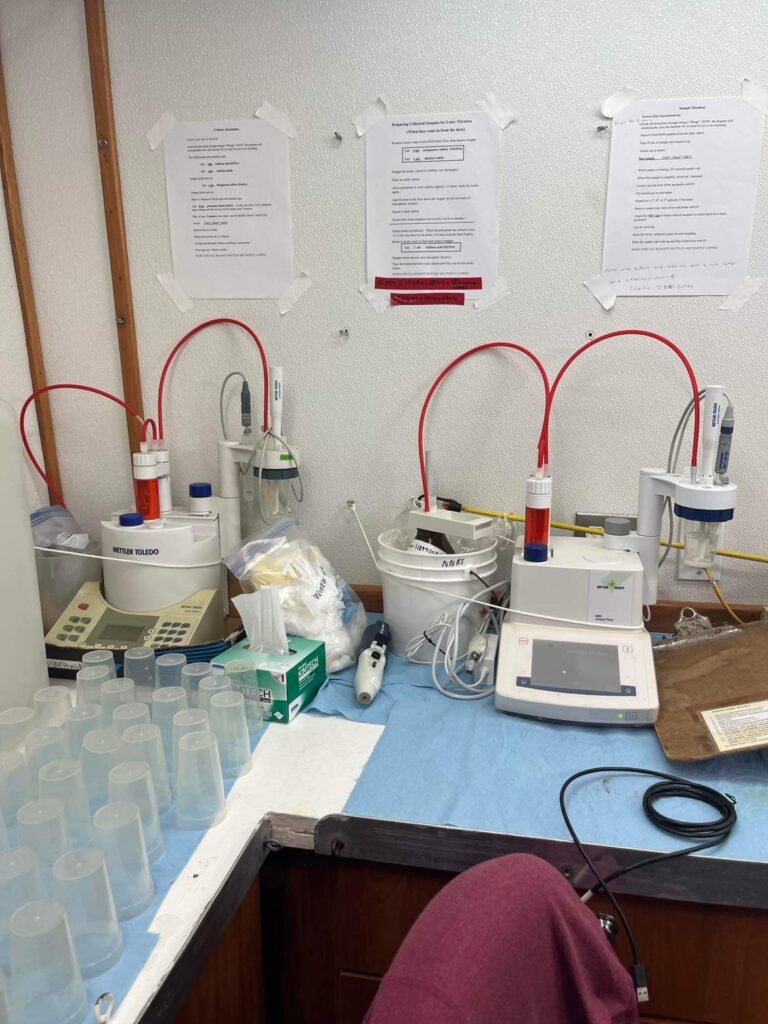
- WEDNESDAYS ARE FOR WET LABS!!!
- Bibbidi-bobbidy - BOOYAH! It’s your cruise fairy coming at you on this beautiful Wednesday (day 4) with some updates and info on what we’ve been up to this far.
From now on, I, the cruise fairy, have decided (with the imaginary power I have) that Wednesdays are for Wet Labs!
Well, at least this Wednesday is anyway. So join me, your cruise fairy, on a wonderful walk through the wet lab we get to use here on the Pelican.

Upon entering, we have a space for the life jackets and hard hats we needed when we were on the back deck collecting samples. (You had yours on out there, too, right?!)
There is also a sink if needed for research like combining through mud samples, but we are currently using it for work gloves and rain gear to be easily accessible when needed.
Crossing over the threshold (where there use to be a door), we enter the part of the lab where all of our samples are processed, stored, or prepped for future processing.
The first contraption we see on the right is a method of processing sediments.

This process requires a vacuum that pulls a volume of water through a pre-weighed filter that collects the sediment on top. Then the filter tower and filter are rinsed with DI water. That filter, now covered in sediment, is frozen and then taken back to the land lab to be weighed and further processed to measure turbidity.
Moving on to the next (similar looking) set of equipment, we have the first part of our chlorophyll processing station.

This station uses the same vacuum-style set up as the sediment (and the same vacuum). However, the individual pieces of equipment differ. Where the sediment is run through a plastic filter tower (the thing that looks like a cup on top), the chlorophyll sample is poured into glass filter towers. The chlorophyll filter is then rolled up like a burrito with forceps (tweezers) and put into a small vial with DMSO (dimethyl sulfoxide) acetone solution and must be placed in the dark. We use some tried and true wooden boxes that have journeyed on this cruise many times before!
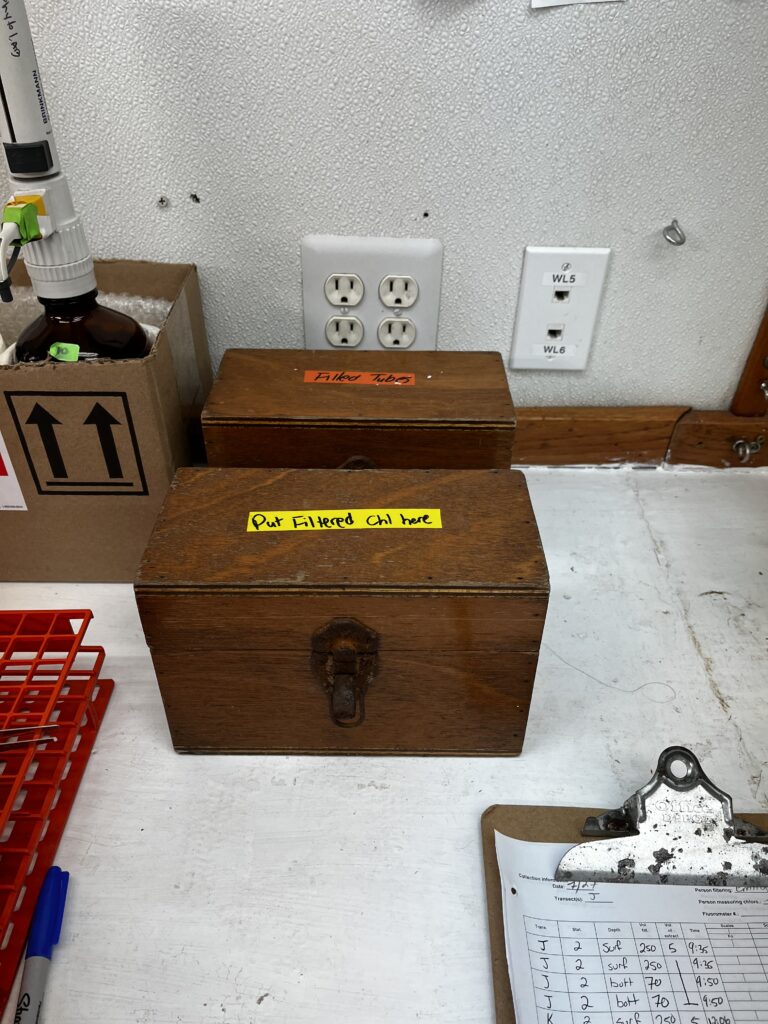
Brock, one of the science crew members on the trip said it looked like you would find treasure when you opened the box.
Perhaps, I might suggest, we do! But once the treasure (the chlorophyll sample) is placed into the box, it has to wait(extract) 2 hours before it can be retrieved again. Two hours later- and no more than 24- the filtered chlorophyll samples are ready to go through the second part of the process!
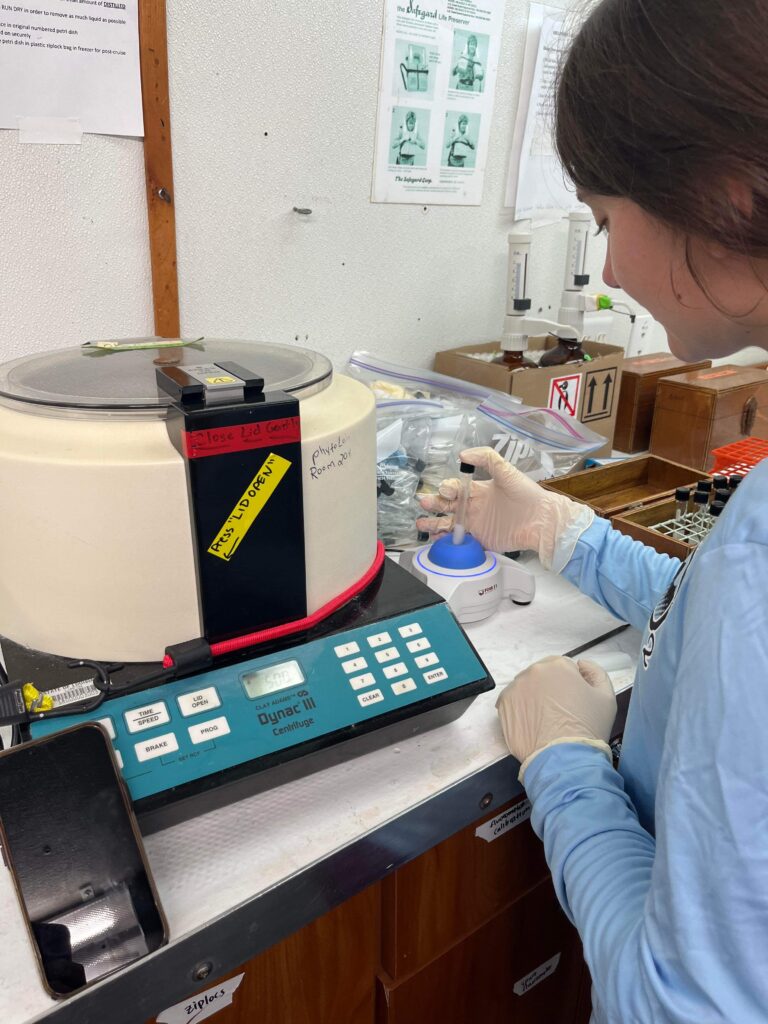
Each chlorophyll tube is vortexed (mixed, intensely) for 30 seconds, the filter is carefully discarded, and then placed into a centrifuge, where it is spun around at 2000 RPMs for 5 minutes to make sure that the remaining filter particles do not impact fluorometer readings.
In between each step, the vials are placed back into the treasure box, as Brock called them! This ensures that the samples become dark acclimated so the fluorometer can properly measure chlorophyll. We want to be sure that the measurements are accurate to that of the location and time that we took the sample initially.
After placed in the centrifuge, the vials go back in their box and await their turn in the fluorometer.
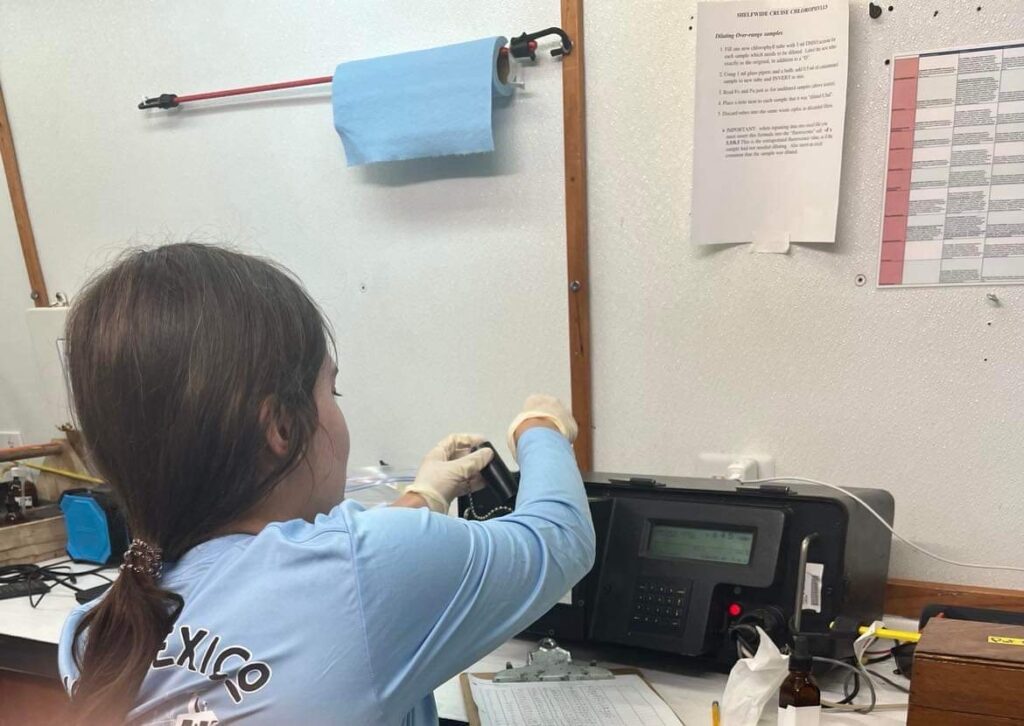
This instrument measures the absorption of light in a fluid. Essentially, the more chlorophyll in the solution, the more light absorbed, the higher the number on the fluorometer. The vial is measured right when it is taken out of the box. Then, hydrochloric acid (HCl) is added to the sample, which converts the chlorophyll to phaeopigments. The same sample is measured a few minutes later, after the HCl has acidified the sample. Both of these recorded measurements are plugged into an equation that helps us determine the amount of chlorophyll that each vial sample had.
The last instrument set up on the starboard side of the wet lab is known as a titrator. *When looking towards the bow/front of the ship, starboard is to your right. When looking towards the stern/back, it’s on your left.*
We use the titrator to measure samples collected in the CTD- specifically, we are measuring the amount of dissolved oxygen in the water. This procedure done on the titrator is compared to the YSI and CTD measurements of Dissolved Oxygen that are taken when the respective instruments are cast into the water themselves. When talking about water being hypoxic, low oxygen, that is determined by measuring the dissolved oxygen in the water.
The last stop on our wonderful journey of the wet lab is the sink where we collect and prep nutrient samples for processing.
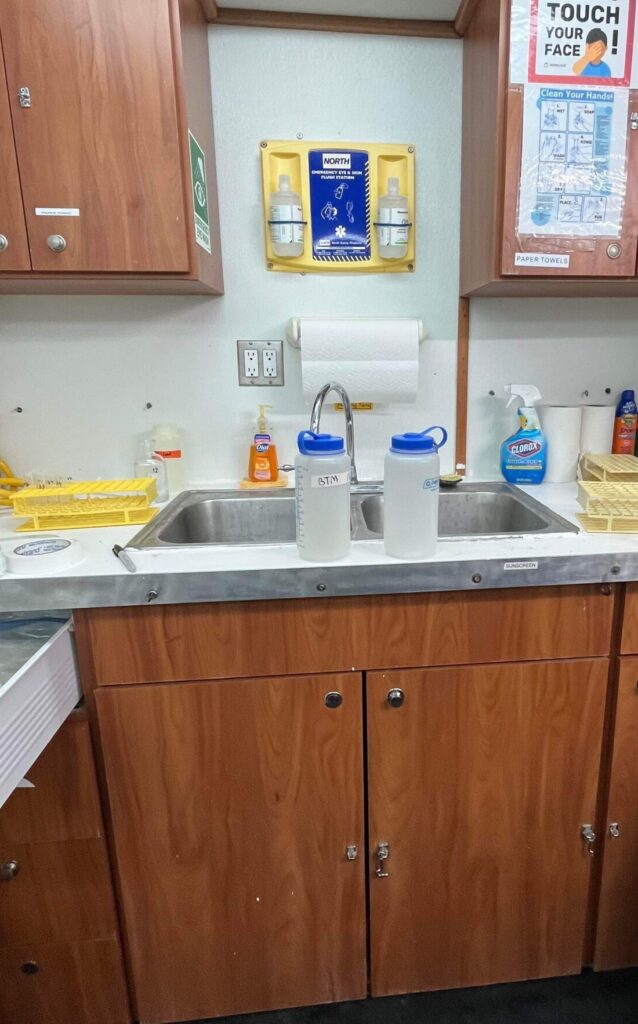
We take both bottom and surface samples of nutrients, just like we take bottom and surface samples of chlorophyll. However, nutrient samples and their replicates (always have spare!) are poured into vials that are then put in the freezer, where they will be taken back to a land lab for processing and analyzing.
Well. The clocks about to strike breakfast time here and we have completed our tour! Time for me to bibbidi bobbidi bounce on over to the galley for a magical meal from Chef Lawrence! I hope you enjoyed the tour. And remember! WEDNESDAYS ARE FOR WET LABS!!!
- Through on THURSDAY?!?!
-
That is right beautiful people! We have finished collecting data on the cruise already- the result of a smaller hypoxic zone (yay!) and very calm weather conditions. We have been bibbidi-bobbidi- BLAZING (in speed and sometimes in temperature) through the Gulf of Mexico on some of the most beautiful days on the water! We have seen clear blue waters with visibility of 18 meters, and we’ve seen murky waters with visibility of a meter. We have seen dolphins and Atlantic sharp nose sharks, phytoplankton and zooplankton, sea nettles and comb jellies, bivalves and worms, and iridescent swimming crabs and a megalops (crab larvae). What a magical place the Gulf of Mexico is!We took our last samples around 15:30 (3:30pm) today. We only have a couple more things to finish up on the R/V Pelican as we begin to transit back to LUMCON. A bit of packing here, a good bit of data entry there. Then, we are bibbidi-bobbidi- back to the land labs for further processing! It’s a bittersweet time, as we love being out in the Gulf, but are glad the trip is shorter this year because there is less hypoxia. Many factors play into the formation of the hypoxic/dead zone. As the science crew and other team members on land begin processing and analyzing things on land, more answers may be revealed in time as to why and how the dead zone of 2023 is what it is.Speaking of other team members, today is also a day to give a HUGE thank you on this Thursday!!!Many people and teams have been a part of this 2023 Gulf Hypoxia cruise and there are many thanks to be given!To each member of the science crew, thank you for bringing your enthusiasm, teamwork, dedication, expertise, desire to learn, and humor to this year’s cruise. It has been a true pleasure and you have brought so much to this year’s trip.To the R/V Pelican vessels crew, thank you for having us onboard for another year! Your knowledge and expertise of your craft is invaluable for us. THANK YOU!Chef Lawrence, thank you for always making sure we were well nourished on this trip! Everything you make is absolutely delicious.To the vessel ops team at LUMCON who coordinated our ability to use the R/V Pelican, thank you! And thank you for being willing to move our cars to higher ground if LUMCON flooded while we were away.To all of the people on land who are a part of this team, thank you for all of your hard work as well!None of this would be possible without the many people who have played a part in this cruise!Finally, thank YOU, reader, for journeying with us and accompanying me, your cruise fairy, on a fun-filled trip of hard work on the beautiful Gulf of Mexico!See you next year!Bibbidi- bobbidi- bye-bye!
